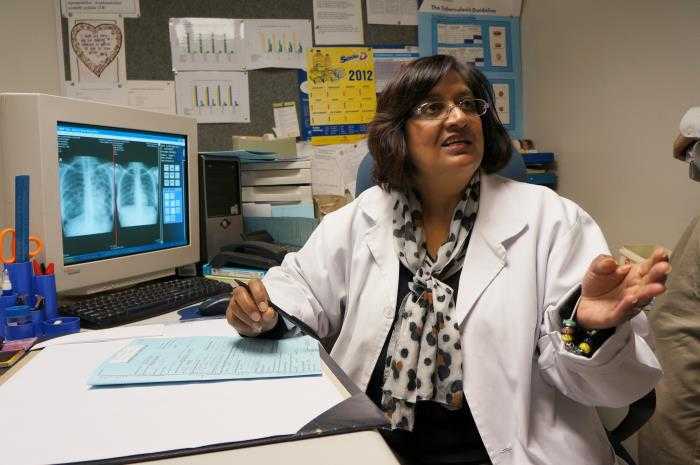Tuberculosis

Created on September 11, 2012, this photograph was captured inside the Prince Cyril Zulu Clinic, the largest government out-patient TB, and STD treatment facility in Durban, South Africa. In this view a clinical radiologist was reviewing a patient’s chest x-ray, discussing her findings with a colleague. The U. S. Centers for Disease Control and Prevention (CDC) supports HIV & TB research at Prince Cyril Zulu Clinic, where results inform the World Health Organization (WHO) and the U.S., as to appropriate guidelines to be followed when treating co-infected patients, and preventing the spread of diseases. Search images by topic on the Public Health Image Library (PHIL)
Tuberculosis (TB) is caused by a bacterium called Mycobacterium tuberculosis. The bacteria usually attack the lungs, but TB bacteria can attack any part of the body such as the kidney, spine, and brain. Not everyone infected with TB bacteria becomes sick. As a result, two TB-related conditions exist: latent TB infection (LTBI) and TB disease. If not treated properly, TB disease can be fatal.
What is the global impact of tuberculosis?
- A fourth of the world’s population, about 2 billion people, are infected by TB bacteria. 1.8 million will die each year, making TB the leading infectious disease killer in the world.
- Of the 10.4 million individuals who become ill with TB each year, approximately four million are “missed” each year by health systems and do not get the care they need, allowing the disease to continue to be transmitted.
- Resistance to anti-TB drugs can occur when these drugs are misused or mismanaged. Examples include when patients do not complete their full course of treatment; when health-care providers prescribe the wrong treatment, the wrong dose, or length of time for taking the drugs; when the supply of drugs is not always available; or when the drugs are of poor quality.
- Multidrug resistant tuberculosis (MDR-TB) is TB resistant to two of the most important drugs used to treat TB: Isoniazid (INH) and Rifampin (RIF).
- Extensively drug resistant TB (XDR-TB) is a rare type of MDR-TB that is resistant to isoniazid and rifampin, plus any fluoroquinolone and at least one of three injectable second-line drugs (i.e., amikacin, kanamycin, or capreomycin). Because XDR-TB is resistant to the most potent TB drugs, patients are left with treatment options that are much less effective.
- XDR-TB is of special concern for persons with HIV infection or other conditions that can weaken the immune system. These persons are more likely to develop TB disease once they are infected, and also have a higher risk of death once they develop TB.
Who is at risk?
- Because the reach of TB is so broad, to effectively and fully address MDR-TB in the U.S., MDR-TB must be addressed globally in the places hardest hit. TB anywhere is TB everywhere – it spreads from person to person and doesn’t respect borders. Recent models show that unless we scale up efforts to address this growing threat, the number of people dying from drug-resistant TB will nearly double every 5 years.
What is CDC doing?
- CDC conducts a wide range of activities to find, cure, and prevent TB, including
- Developing innovative approaches to find and treat the roughly 4 million people each year who develop TB disease who are either undiagnosed, unreported, or inappropriately treated
- Strengthening lab networks and surveillance systems to allow for fast and accurate diagnosis of TB cases
- Identifying the best methods to diagnose TB among children and people living with HIV
- Conducting research to identify better, less toxic treatment regimens that cure patients faster
- Shoring up basic TB prevention and infection control efforts around the world to break the cycle of transmission and prevent the development of drug resistance
- Establishing best practices to end TB transmission in health facilities
- Providing HIV testing to TB patients and supporting HIV treatment for people living with HIV and TB co-infection
- Expanding TB therapy for people living with HIV, whose weakened immune systems make them more vulnerable to becoming ill from TB
Additional Resources
- Global Tuberculosis Fact Sheets
- Read CDC’s latest global tuberculosis news releases
- Browse Global TB images on the CGH Flickr stream or search by topic or country
- Search images by topic on the Public Health Image Library (PHIL)
- Learn more about tuberculosis
- Explore key facts about the global HIV & TB epidemics
Contact Media Relations
Contact media relations to speak with a CDC tuberculosis expert
-
9:00 a.m. – 6:00 p.m.
(404) 639-3286
media@cdc.gov
-
After Hours
(770) 488-7100
Media Request Form
- Page last reviewed: September 7, 2017
- Page last updated: September 7, 2017
- Content source:
Global Health
Notice: Linking to a non-federal site does not constitute an endorsement by HHS, CDC or any of its employees of the sponsors or the information and products presented on the site.


 ShareCompartir
ShareCompartir